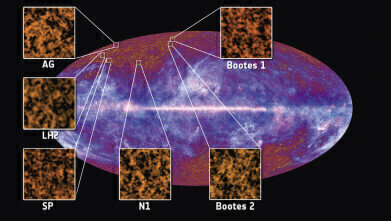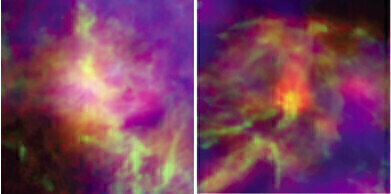-
 Six areas of the sky in which distant galaxies can be seen by Planck, overlaid on the Planck’s first all-sky image. The emission from our own galaxy, seen in blue and white, has to be removed before the distant population of galaxies can be seen. Each square inset image is around 100x the size of the Full Moon. Image credit: ESA / Planck Collaboration.
Six areas of the sky in which distant galaxies can be seen by Planck, overlaid on the Planck’s first all-sky image. The emission from our own galaxy, seen in blue and white, has to be removed before the distant population of galaxies can be seen. Each square inset image is around 100x the size of the Full Moon. Image credit: ESA / Planck Collaboration. -
 Two of the regions studied to investigate the anomalous microwave emission, in the constellations of Perseus (left) and Ophiuchus (right). The blue shows radio waves, emitted by electrons moving in the interstellar medium. The green shows the dust seen at farinfrared and sub-millimetre wavelengths, and traces the sites of star formation. The red regions show the anomalous microwave emission. This emission is thought to be caused by tiny dust grains spinning tens of billions of times every second. Each image is around 5 degrees on a side. Image credit: ESA / Planck Collaboration.
Two of the regions studied to investigate the anomalous microwave emission, in the constellations of Perseus (left) and Ophiuchus (right). The blue shows radio waves, emitted by electrons moving in the interstellar medium. The green shows the dust seen at farinfrared and sub-millimetre wavelengths, and traces the sites of star formation. The red regions show the anomalous microwave emission. This emission is thought to be caused by tiny dust grains spinning tens of billions of times every second. Each image is around 5 degrees on a side. Image credit: ESA / Planck Collaboration.
News & Views
Planck unveils wonders of the Universe
Apr 15 2011
The first scientific results from Europe’s Planck spacecraft -which has been focusing on the coldest objects in the Universe,- include an exciting variety of astronomical finds, from massive galaxy clusters to new, unidentified objects. The UK Space Agency funds the UK’s involvement in both of Planck’s scientific instruments. Astronomers from around the UK are now heavily involved in the operation of these instruments and data interpretation.
Dr David Parker, Director of Space Science and Exploration for the UK Space Agency, said: “We’re proud to be playing a key role in this amazing discovery machine. These new results are all vital pieces of a jigsaw that could give us a full picture of the evolution of both our own cosmic backyard – the Milky Way galaxy that we live in – as well as the early history of the whole Universe.”
Prof George Efstathiou, University of Cambridge and member of the Planck Science Team, said: “Planck was designed intentionally to have a wide scientific reach, extending well beyond its primary scientific goal of investigating the very first moments after the Big Bang. Planck’s scientific diversity is striking in this first release of scientific results. There are new discoveries on dust and cold gas in our Galaxy, star forming regions, very distant galaxies and clusters of galaxies. These early results provide just a first glimpse of Planck’s scientific potential. I expect much more to come in the next two years.”
The new results include evidence for an otherwise invisible population of galaxies shrouded in dust billions of years in the past, which formed stars at rates some 10–1000 times higher than we see in our own galaxy today.
Data collected by Planck is now enabling scientists to remove some of the overlying contamination or ‘fog’ so that the first measurement of this population at these wavelengths can be achieved. The data collected confirms the theory that the overlying contamination is coming from dust grains spinning at several tens of billion times a second by collisions with either fast-moving atoms or packets of ultraviolet light.
This new understanding helps to remove this local microwave ‘fog’ from the Planck data with greater precision, leaving the cosmic microwave background untouched. “This is a great result made possible by the exceptional quality of the the Planck data,” said Dr Clive Dickinson, University of Manchester, UK.
Digital Edition
Lab Asia 31.2 April 2024
April 2024
In This Edition Chromatography Articles - Approaches to troubleshooting an SPE method for the analysis of oligonucleotides (pt i) - High-precision liquid flow processes demand full fluidic c...
View all digital editions
Events
Apr 25 2024 Istanbul, Turkey
Apr 28 2024 Montreal, Quebec, Canada
May 05 2024 Seville, Spain
InformEx Zone at CPhl North America
May 07 2024 Pennsylvania, PA, USA
May 14 2024 Oklahoma City, OK, USA

















